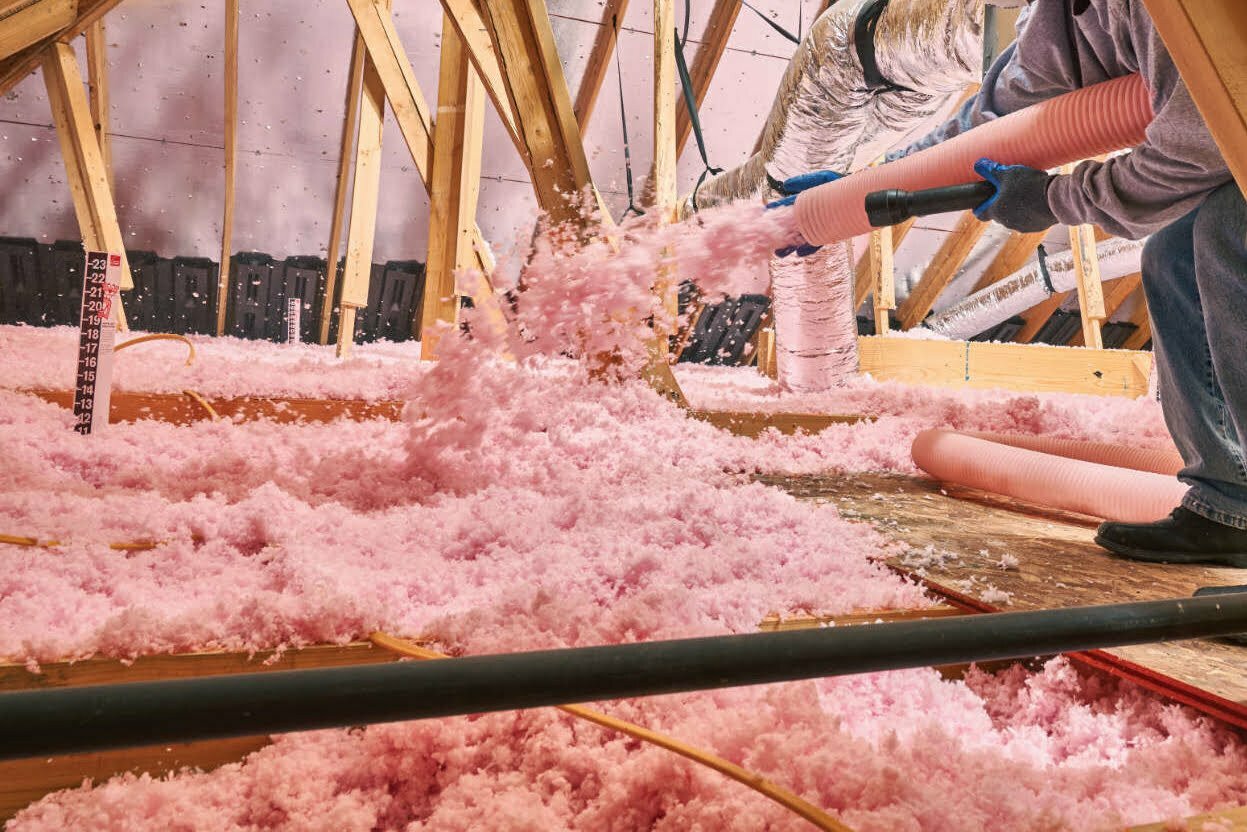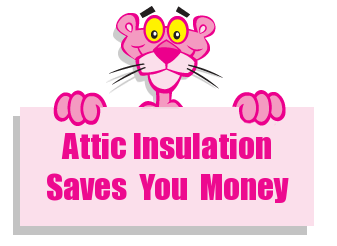Insulating your home properly is an investment that can improve your comfort and result in considerable energy savings over time. Among the many insulation options available in the market, blown-in insulation stands out because of its unique installation method and benefits. But is it worth the cost? Let’s dive in.
Understanding Blown-in Insulation
Blown-in insulation, a commonly used insulation material, is a home improvement technique that involves pumping insulation materials into stud spaces or wall cavities. Let’s dive in to further understand what blown-in insulation is, its types, how it’s installed, and its costs.
What is Blown-in Insulation?
Blown-in insulation (sometimes called loose-fill insulation) is typically installed in attics, walls, and other areas of a building to improve thermal efficiency and energy efficiency. This insulation is called “blown-in” because it is installed by blowing or spraying the insulation material into the desired space using special equipment. This process is best done by a professional.
Blown-in insulation is favored for several reasons:
- It can be installed quickly and efficiently, making it a cost-effective choice for insulating large or irregularly shaped spaces.
- It fills gaps and voids effectively, creating a continuous thermal barrier.
- It can be added to existing insulation to improve its performance.
- Blown-in insulation is particularly well-suited for insulating attics and wall cavities.
Types of Blown-in Insulation
There are three primary types of blown-in insulation: Cellulose, fiberglass, and mineral wool:
- Fiberglass: This is one of the most popular materials for blown-in insulation. It consists of tiny glass fibers that are blown into the designated space. Fiberglass insulation is known for its effectiveness in reducing heat transfer and is available in various forms, including loose-fill and batts.
- Cellulose: Cellulose insulation is made from recycled paper products, such as newspaper, cardboard, or other paper-based materials. It is treated with fire retardants and chemicals to make it resistant to fire, pests, and mold. Cellulose insulation is eco-friendly and offers good thermal performance.
- Rock Wool or Mineral Wool: This insulation material is made from natural minerals, such as basalt or slag, which are melted and spun into fibers. Rock wool insulation provides good thermal resistance and is also fire-resistant and resistant to pests.
How is Blown-in Insulation Installed?
Blown-in insulation is installed using specialized equipment and a systematic process to ensure even distribution and effective coverage. The installation process typically involves the following steps:
- Preparation: First, the installer should ensure the work area is clean and free of debris. They will seal any gaps or openings in the building structure to prevent the insulation from escaping or settling in unintended areas.
- Measure and Calculate: Next, the installer calculates the amount of insulation material required for the specific area you are insulating. This calculation takes into account the desired R-value and the area’s dimensions.
- Equipment Setup: Now, the installer sets up the blowing equipment, which typically consists of a blowing machine and a long hose attached to it. The insulation material is loaded into the machine’s hopper.
- Install Insulation: Now it’s time to position the hose at the starting point of the installation area, such as an attic or wall cavity. Then, the installer starts the blowing machine, which agitates and breaks up the insulation material, turning it into a loose, fluffy consistency. They will then feed the loose insulation material into the hose, and it is blown or sprayed into the desired space.
- Distribution: The installer should work systematically to distribute the insulation evenly throughout the area. They will move the hose in a methodical pattern to ensure uniform coverage.
- Density Adjustment: Some blown-in insulation materials, like cellulose, may require adjustment of the density to achieve the desired R-value. This can be done by varying the amount of material applied in different areas.
- Leveling and Smoothing: After filling the desired depth of insulation, the installer will use a leveling tool to ensure an even surface and uniform thickness.
- Quality Control: Now it’s time to inspect the installed insulation to ensure there are no gaps or voids. The installer should verify that the insulation reaches the recommended R-value for your climate zone and the specific area being insulated.
- Clean-Up: Next, the installer will clean up any excess insulation material that may have spilled or escaped during installation and properly dispose of any waste materials in accordance with local regulations.
- Sealing and Completing: Finally, the installer will seal access points or openings in the insulation, such as attic hatches or wall penetrations. If needed, they can reinstall any removed or modified building components, such as drywall or attic flooring.
It’s important to note that blown-in insulation should be installed by trained professionals who are experienced in using the specialized equipment and techniques required for the job. Proper installation is crucial to achieving the desired insulation performance and energy efficiency improvements in your home.
Analyzing the Costs of Blown-in Insulation
Direct Costs of Materials and Installation
Insulation costs typically depend on the type of insulation material and the square footage to be covered. For instance, fiberglass insulation is cheaper than cellulose insulation cost, but more expensive than natural wool. However, the insulation material cost forms just one part of the equation. The labor costs might tip the scales.
Labor cost typically includes the time and effort it takes to install the insulation as well as for cleaning up afterward. It is possible to rent a blowing machine and do it yourself, but remember that installing blown insulation is a complex task that could lead to additional costs if not done correctly.
Indirect Costs: Energy Savings and Efficiency
One of the most significant indirect benefits of adding insulation is the improvement in energy efficiency, leading to reduced energy bills. Homeowners can expect a noticeable decrease in their energy bills after the installation of blown-in insulation.
Long-term Maintenance and Replacement Costs
While calculating the total cost, homeowners should also factor in the long-term maintenance and replacement costs. Fiberglass, cellulose, or natural wool blown insulation may settle over time, requiring additional insulation periodically or even replacement. However, with proper maintenance, blown-in insulation should last for 20-30 years without needing to be replaced.
Comparison to Other Insulation Methods
With these cost factors in mind, let’s compare blown-in insulation to other popular methods.
Blown-in Insulation vs. Batt Insulation
Compared to batt insulation (pre-cut panels of fiberglass or mineral wool), blown-in insulation is much more flexible. It reaches odd-sized or irregular wall cavities and offers a more consistent coverage. That’s why blown-in insulation is ideal for existing homes with unusual wall framing or difficult access areas. Plus, it’s also great to use over existing insulation for an extra layer of protection. However, keep in mind that labor costs can be higher with blown-in insulation, and installing it might be more complex.
Blown-in Insulation vs. Foam Insulation
Blown-in insulation is generally less expensive than spray foam. However, spray foam offers higher R-values per square foot, which means increased resistance to heat transfer and better energy efficiency. A professional insulation installer can help you decide if spray foam or blown-in insulation is better for your space. Because of the nature of spray foam insulation, it cannot be installed in closed wall cavities.
Choosing the Right Insulation for Your Home
Finding the right insulation starts by assessing your current insulation state and understanding your home’s characteristics. Rely on trusted local insulation experts to guide you through the process and give accurate quotes based on your house’s square footage and insulation needs. When it comes to costs, always consider the labor cost and insulation material costs. Total cost, however, should not be your only deciding factor. The longevity, effectiveness, installation process, and potential energy savings are equally, if not more, important.
Remember that investing in appropriate insulation is a long-term game. The additional costs initially incurred will eventually pay off by decreasing your energy bills and ensuring consistent comfort in your home.
Summary: Is Blown-in Insulation Worth It?
Factors to Consider in Determining Worth
With these features in mind, it’s time to decide if blown-in insulation is right for you. While the final cost is important, it’s equally essential to consider the long-term savings. Here are factors to consider to help you decide if blown-in insulation is a worthwhile investment:
- Energy Savings: Blown-in insulation can significantly improve the energy efficiency of your home by reducing heat transfer. It helps maintain more consistent indoor temperatures, which can lead to lower heating and cooling bills over time. If you plan to stay in your home for a while, the energy savings can make blown-in insulation cost-effective in the long run.
- Comfort: Adequate insulation contributes to a more comfortable living environment. Blown-in insulation can help reduce drafts, cold spots, and temperature fluctuations within your home, enhancing overall comfort.
- Climate: The climate in your region plays a crucial role in the value of blown-in insulation. If you live in an area with extreme temperatures, such as very cold winters or hot summers, proper insulation becomes even more important. Blown-in insulation can help regulate indoor temperatures and reduce the strain on your heating and cooling systems.
- Retrofitting: Blown-in insulation is a viable option for retrofitting existing homes. If your home lacks sufficient insulation or has older insulation that needs an upgrade, blown-in insulation can be a cost-effective solution compared to more extensive renovations.
- Versatility: Blown-in insulation can be used in various parts of your home, including attics, walls, and floors. Its adaptability to different areas makes it a versatile choice for improving insulation throughout your home.
- Installation Costs: The initial installation cost of blown-in insulation can vary depending on factors such as the type of material used, the area to be insulated, and labor costs. Compare these costs to the potential long-term energy savings to determine if the investment is worthwhile.
- Professional Installation: Proper installation by trained professionals is essential for achieving the full benefits of blown-in insulation. Ensure that you hire a reputable contractor with experience in installing the chosen insulation material.
Choose Cincinnati RetroFoam for Your Insulation Needs
Since 2015, Cincinnati RetroFoam has offered premium insulation to homeowners that isn’t available anywhere else. Our mission is to provide impeccable service and give our best at every job to give you lasting comfort and long-term savings.
We offer a range of insulation services, including blown-in insulation, injection foam, and spray foam. We work on existing homes, new construction, pole barns, and commercial properties. Whatever your insulation needs are, we’re here for you. We also offer financing options if you’re looking for ways to manage insulation costs. Let us serve as your trusted partner for your upcoming insulation project. Contact us today to get your free quote.
Frequently Asked Questions
Can you over-insulate an attic?
Yes, if you choose the wrong type of insulation, you can over-insulate your attic. It’s always best to work with professionals for your insulation needs to avoid this problem.
Does insulation increase home value?
Yes, a properly insulated home can improve your property value.


